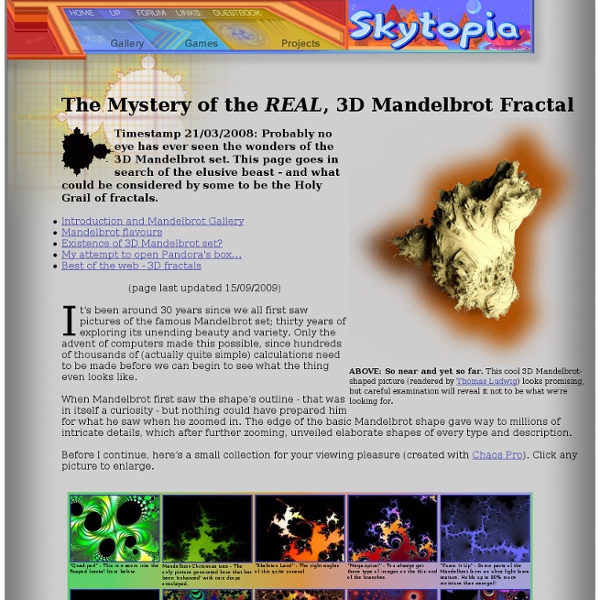The Mandelbrot Set
Understanding Mathematics by Peter Alfeld, Department of Mathematics, University of Utah The Mandelbrot Set. Note: All of the Mandelbrot pictures on this page were generated with the applet on this page! The first picture ( No1 ) shows a small part of the Mandelbrot set (which is rendered in red). List of Contents What's so special about the Mandelbrot set? What is the Mandelbrot set? z(0) = z, z(n+1) = z(n)*z(n) + z, n=0,1,2, remains bounded. You may ask, what's so special about the particular iteration (1), and why do we use complex numbers instead of real ones. Much of the fascination of the Mandelbrot set stems from the fact that an extremely simple formula like (1) gives rise to an object of such great complexity. Consider this picture ( Title ). One of the most widely read basic introductions to the Mandelbrot set and other fractals is by H. I got pretty excited about this program because Java enabled me to create beautiful things so easily. This is what you should see. Max.
Hypercomplex Fractals
Here is a 4th order inverse Juliabulb set with 600 million spheres. The triplex raised to the 4th power has 16 unique valid roots. Garth Thornton was the first person to point out that, in general, the triplex raised to the nth power has n2 unique valid roots. I posted a formula for all integer powers here.
Galeries d'images fractales
Benoît Mandelbrot
Benoît Mandelbrot is not an artist in the usual sense of the word. He doesn’t work with oils, watercolors, pastels or colored pencils, yet he has created work of extraordinary beauty. Benoît Mandelbrot is a mathematician. He coined the term “fractal” in 1975 to describe a shape that appears similar at all levels of magnification. The nature of cloud formations, seemingly too complex for traditional geometry and mathematics to describe, is revealed to be an expression of fractal geometry. Mandelbrot worked with this branch of math and in the process created one of those wonderfully simple and elegant mathematical expressions, like Einstein’s “E=Mc2”, that is incredibly far reaching. The arrows on the equal sign indicate that the equation can be processed in either direction, and the result of one operation can become the start of the next, ad infinitum, in a process known as iteration. This raises some always fascinating questions about the nature of art and beauty.
Software 3D graphics - index
untitled
Mandelbrot Set - Labix
Introduction These snippets compute and draw a graphic representation for the classical Mandelbrot set fractal. Results Running under pygame: Running under a Nokia 770 with pymaemo (also pygame): Running under a Nokia N70 with Python for Series 60: Code for pygame Toggle line numbers Code for Series 60 Author Gustavo Niemeyer <gustavo@niemeyer.net> CategorySnippet
What is a Mandelbox - Mandelbox
A Mandelbox is a box-like fractal object that shares several properties with the well known Mandelbrot set; it is a map of continuous, locally shape preserving Julia sets. This means the object varies at different locations, since each area uses a Julia set fractal with a unique formula. Like the Mandelbrot set a Mandelbox is calculated by applying a formula repeatedly to every point in space. That point v is part of a Mandelbox if it does not escape to infinity. In fact it replaces the Mandelbrot equation z = z2 + c with: v = s*ballFold(r, f*boxFold(v)) + c where boxFold(v) means for each axis a: if v[a]>1 v[a] = 2-v[a] else if v[a]<-1 v[a] =-2-v[a] and ballFold(r, v) means for v's magnitude m: if m<r m = m/r^2 else if m<1 m = 1/m The standard Mandelbox uses this formula with s=2, r=0.5 and f=1. Unlike the Mandelbrot set a Mandelbox can exist in any number of dimensions. Properties It is probably a multi-fractal, which means it doesn't have a single fractal dimension measure, however:
[ wu :: fractals ]
A Short And Entertaining Introduction to Fractals usually one's first response to fractals is simply this: they are beautiful! indeed, they are visually arresting, and there are many reasons why. perhaps one reason is that they exhibit extreme levels of symmetry, a property we have gravitated toward throughout human history, whether it be in our architectural designs, in our scientific theories, in our religions, or even in the facial structures of the opposite sex. another reason could be that the same self-replicative patterns can be found strewn throughout our natural universe, in vapor trails, snail shells, evergreens, cauliflowers, and snowflakes ... just to name a few. but perhaps most enticing is a reason most people would never guess -- mathematical brevity. many of these stunning patterns are governed by very simple-looking equations consisting of only a few symbols!
Mandelbox и Mandelbulb. 3D фракталы это красиво
Mandelbox и Mandelbulb. 3D фракталы это красиво Mandelbox – фрактал кубической формы, который нашел Tom Lowe в 2010 году. ----------------------<cut>---------------------- используется формула: v = s*ballFold(r, f*boxFold(v)) + c Где: v = s * ballFold(r, f*boxFold(v)) + c: — v: 3d point — boxFold(v) means for each axis a: if v[a] > 1 v[a] = 2 – v[a] else if v[a] < -1 v[a] = -2 – v[a] — ballFold(r, v) means for v's magnitude m: if m < r m = m/r^2 else if m < 1 m = 1/m^2 Стандартный Mandelbox использует формулу с s=2, r=0.5 and f=1. Любой современный 3D редактор подавится таким количеством полигонов, поэтому вся эта красотень строится специальной программой Mandelbulber 0.80, а рендерится в Adobe After Effects при помощи специального плагина Настоятельно рекомендую смотреть в HD Еще пару картинок



